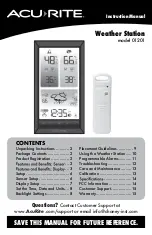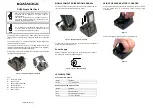
19
WeatherHawk®
815 W 1800 N Logan, UT 84321-1784, Email:
Toll free in USA: 866-670-5982, International: 435-227-9802, FAX: 435-227-9749 Printed 2013
5 W Solar Panel
Procedure 4: Solar Panel Installation
1.
Place the solar panel on the mast below the station to the maximum
distance allowed by the solar panel cable.
2.
Loosely tighten the U-bolt so that the solar panel is stable but can be
rotated on the mast or pole.
3.
Use a compass (supplied in the optional Tripod Installation Kit) to
properly align the solar panel. If the site is in the northern hemisphere, the glass surface of the panel should
face south. If the site is in the southern hemisphere, the glass surface of the
panel should face north.
4.
Connect the cable to the WeatherHawk connector labeled “Solar Panel”.
Procedure 5: TP1-GR Ground Kit Installation
a. Proper earth grounding of the system may be required for both personal safety and reliable system
function, we recommend a qualified electrician install the grounding kit.
b. If the station is directly connected to the Host computer but not properly grounded and isolated, the
Host computer can be damaged by environmentally induced electrical surges.
c. This kit is for ground installations only. Do not use the TP1-GR kit for rooftop installations. A
qualified electrician should specify and install the earth ground system for a roof mounted weather
station, if required.
Ground rod
#4 stranded copper cable
14 AWG copper wire
Tripod coupling
Ground rod coupling













































